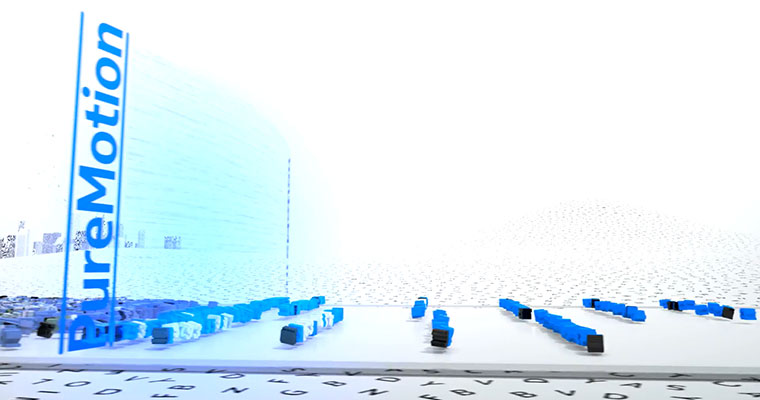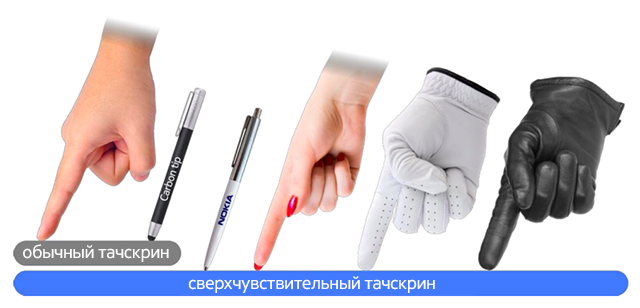Nokia PureMotion: how new Nokia screens work
In the review of our newest smartphone, the Nokia Lumia 920, we mentioned the PureMotion HD + technology, which combines twice the switching speed of pixels than any other screen, phenomenal brightness and touch responsiveness with gloves. This time we will tell how it all works.
All displays used in modern smartphones - for example, liquid crystal or organic LEDs - are not able to reproduce a clear image with a high frame rate. While the hardware and software of smartphones is capable of rendering an image with a frame frequency of 60 frames per second, the displays do not “catch up” with such a frame rate.

')
In conventional IPS-type liquid crystal arrays used in mobile devices, the pixel transition takes about 23 ms, while simple arithmetic suggests that for 60 frames per second the transition should be 16.7 ms. As a result, when viewing dynamic clips, system animation, and simple scrolling of content, the user sees a late, blurred image.
In most LCD displays, the response time of a pixel when switching between black and white colors is less than when switching between grayscale. This is especially true for matrices with nematic liquid crystals (Twisted Nematic, TN) and matrices with vertical alignment of liquid crystals (Vertical Alignment, VA). On the other hand, IPS-type matrixes show much smaller visual changes in the transition between grayscale: the potential difference between the initial and final states that drives the crystals is smaller, which leads to slower liquid crystal molecules, especially at low temperatures.
To accelerate the matrix, you need to apply more voltage to the electrodes, between which liquid crystals are clamped. The problem with this method is the need to calculate this voltage as accurately as possible. The engineers who develop the PureMotion technology succeeded, thanks to which the new Nokia Lumia 920 clearly and smoothly reproduces dynamic scenes in movies and games, as well as animations of the OS interface and applications, like no other smartphone.
Ultimately, the acceleration of the matrix contributes to both the reduction of the pixel on / activation time (rise time) and the transition homogeneity, as can be seen in the graphs below. On them, the height of the bars indicates the transition time.

Comparison of transition time of pixels in conventional IPS-matrices and in Nokia Lumia 920
To prevent motion from being blurred at 60 frames per second, the liquid crystals must complete their movement from the previous frame before starting the next frame. This means that the transition time of liquid crystals should be less than the time to display one frame. Thanks to the PureMotion overdrive, the pixels of the display complete the transition long before the next transition of pixels needed to draw a new frame - this avoids the blurred image.
In bright sunlight, most displays are practically impossible to read - and this is quite a serious problem for users. PureMotion, using innovations technology ClearBlack, allows you to forget about this lack of modern displays.
In addition to very low reflectivity, which greatly improves the transmission of dark colors in daylight, PureMotion uses a high brightness mode using LED backlighting and increasing image contrast.

Visibility of dark shades in bright sunlight
With very bright lighting at the PureMotion display, the Nokia Lumia 920 turns on the LED backlight with maximum brightness. This happens in automatic mode due to data from the light sensor. An adaptive increase in image contrast compensates for a drop in contrast caused by the inevitable reflection of daylight inside the display with a number of polarization layers. Due to the constant change of colors and contrast of the graphical interface, calculated mathematically and depending on ambient light, the user always gets the best image quality.
Our first PureMotion display has a resolution of 1280x768 pixels - this resolution is also called WXGA. We call this screen HD + because the WXGA resolution has 7% more pixels than 720p, and the aspect ratio of this screen is 15: 9. Also, WXGA has 60% more pixels than DVGA screens (960x640).
The HD + resolution perfectly balances between the convenience of viewing the content and the convenience of the user interface. The 15: 9 aspect ratio looks more attractive than 16: 9, because the interface elements located at the top of the screen are closer to the fingers. To use the Nokia Lumia 920, you do not need a finger extension, which Professor Farnsworth of Futurama could not come up with.

With the change of resistive capacitive screens, it became possible to use the smartphone screen only with your fingers - all alternatives like using nails, gloves, pens, etc. disappeared.
Nokia Lumia 920 and Nokia Lumia 820 are the first phones since 2007 that can recognize touches not only with your fingers, but also with other objects.

This was made possible through the use of touch sensors Synaptics ClearPad 3250, located directly in the display cell: because of this arrangement, the screen sensitivity level in the new Nokia Lumia was three times higher than in other mobile devices. The touch sensors of the Synaptics ClearPad 3250 can simultaneously recognize up to 10 taps, their area and character (hand, glove, pen, etc.). In order to avoid accidental touches, for example, in your pocket, you use a proximity sensor that blocks the screen.
In winter, our fingers are frozen!
Fast display
All displays used in modern smartphones - for example, liquid crystal or organic LEDs - are not able to reproduce a clear image with a high frame rate. While the hardware and software of smartphones is capable of rendering an image with a frame frequency of 60 frames per second, the displays do not “catch up” with such a frame rate.

')
In conventional IPS-type liquid crystal arrays used in mobile devices, the pixel transition takes about 23 ms, while simple arithmetic suggests that for 60 frames per second the transition should be 16.7 ms. As a result, when viewing dynamic clips, system animation, and simple scrolling of content, the user sees a late, blurred image.
Fast responsiveness of liquid crystals and “overdrive” matrix
In most LCD displays, the response time of a pixel when switching between black and white colors is less than when switching between grayscale. This is especially true for matrices with nematic liquid crystals (Twisted Nematic, TN) and matrices with vertical alignment of liquid crystals (Vertical Alignment, VA). On the other hand, IPS-type matrixes show much smaller visual changes in the transition between grayscale: the potential difference between the initial and final states that drives the crystals is smaller, which leads to slower liquid crystal molecules, especially at low temperatures.
To accelerate the matrix, you need to apply more voltage to the electrodes, between which liquid crystals are clamped. The problem with this method is the need to calculate this voltage as accurately as possible. The engineers who develop the PureMotion technology succeeded, thanks to which the new Nokia Lumia 920 clearly and smoothly reproduces dynamic scenes in movies and games, as well as animations of the OS interface and applications, like no other smartphone.
Ultimately, the acceleration of the matrix contributes to both the reduction of the pixel on / activation time (rise time) and the transition homogeneity, as can be seen in the graphs below. On them, the height of the bars indicates the transition time.

Comparison of transition time of pixels in conventional IPS-matrices and in Nokia Lumia 920
To prevent motion from being blurred at 60 frames per second, the liquid crystals must complete their movement from the previous frame before starting the next frame. This means that the transition time of liquid crystals should be less than the time to display one frame. Thanks to the PureMotion overdrive, the pixels of the display complete the transition long before the next transition of pixels needed to draw a new frame - this avoids the blurred image.
Brightness
In bright sunlight, most displays are practically impossible to read - and this is quite a serious problem for users. PureMotion, using innovations technology ClearBlack, allows you to forget about this lack of modern displays.
In addition to very low reflectivity, which greatly improves the transmission of dark colors in daylight, PureMotion uses a high brightness mode using LED backlighting and increasing image contrast.

Visibility of dark shades in bright sunlight
With very bright lighting at the PureMotion display, the Nokia Lumia 920 turns on the LED backlight with maximum brightness. This happens in automatic mode due to data from the light sensor. An adaptive increase in image contrast compensates for a drop in contrast caused by the inevitable reflection of daylight inside the display with a number of polarization layers. Due to the constant change of colors and contrast of the graphical interface, calculated mathematically and depending on ambient light, the user always gets the best image quality.
Lots and lots of pixels: HD +
Our first PureMotion display has a resolution of 1280x768 pixels - this resolution is also called WXGA. We call this screen HD + because the WXGA resolution has 7% more pixels than 720p, and the aspect ratio of this screen is 15: 9. Also, WXGA has 60% more pixels than DVGA screens (960x640).
The HD + resolution perfectly balances between the convenience of viewing the content and the convenience of the user interface. The 15: 9 aspect ratio looks more attractive than 16: 9, because the interface elements located at the top of the screen are closer to the fingers. To use the Nokia Lumia 920, you do not need a finger extension, which Professor Farnsworth of Futurama could not come up with.

Most sensitive screen
With the change of resistive capacitive screens, it became possible to use the smartphone screen only with your fingers - all alternatives like using nails, gloves, pens, etc. disappeared.
Nokia Lumia 920 and Nokia Lumia 820 are the first phones since 2007 that can recognize touches not only with your fingers, but also with other objects.

This was made possible through the use of touch sensors Synaptics ClearPad 3250, located directly in the display cell: because of this arrangement, the screen sensitivity level in the new Nokia Lumia was three times higher than in other mobile devices. The touch sensors of the Synaptics ClearPad 3250 can simultaneously recognize up to 10 taps, their area and character (hand, glove, pen, etc.). In order to avoid accidental touches, for example, in your pocket, you use a proximity sensor that blocks the screen.
In winter, our fingers are frozen!
Source: https://habr.com/ru/post/152671/
All Articles